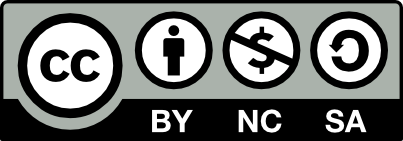18.8: Chapter 10- Memory Types and Stages
- Page ID
- 118706
This page is a draft and under active development. Please forward any questions, comments, and/or feedback to the ASCCC OERI (oeri@asccc.org).
Learning Objectives
- Summarize main features of the case of Kim Peek and speculate on what might be taking place in his brain to account for his extraordinary memory
- Compare and contrast explicit and implicit memory, identifying the features that define each.
- Explain the stages and types of memory and the characteristics of each
- Summarize the capacities of short-term memory and explain how working memory is used to process information in it
- Discuss categories, prototypes and schemas, and their relationship to memory
- Describe counterfactual thinking
Overview
We begin this supplementary section with an example of extraordinary memory in a person with autism. Memory which is so unusual inspires questions about what features of the brain of this individual make his memory so exceptional.
Memory and cognition are the two major interests of cognitive psychologists. The cognitive school was influenced in large part by the development of the electronic computer. Psychologists of this tradition conceptualize memory in terms of types, stages, and processes.
Two types of memory are explicit and implicit. Explicit memory is assessed using measures in which the individual being tested must consciously attempt to remember the information. Explicit memory includes semantic and episodic memory. Explicit memory tests include recall memory tests, recognition memory tests, and measures of relearning (also known as savings).
Implicit memory refers to the influence of experience on behavior, even if the individual is not aware of those influences. Implicit memory is made up of procedural memory, classical conditioning effects, and priming. Priming refers both to the activation of knowledge and to the influence of that activation on behavior. An important characteristic of implicit memories is that they are frequently formed and used automatically, without much effort or awareness on our part.
Stages of memory are sensory, short-term or working memory, and long-term memory. Sensory memory, including iconic and echoic memory, is a memory buffer that lasts only very briefly and then is forgotten, unless it is attended to and passed on for more processing in short-term memory.
Information that we turn our attention to may move into short-term memory (STM). STM is limited in both the length and the amount of information it can hold. Working memory is a set of memory procedures or operations that operates on the information in STM. Working memory’s "central executive" directs the strategies used to keep information in STM, such as maintenance rehearsal, visualization, and chunking.
Long-term memory (LTM) is memory storage that can hold information for days, months, and years. The information that we want to remember in LTM must be encoded and stored, and then retrieved. Some strategies for improving LTM include elaborative encoding, relating information to the self, making use of the forgetting curve and the spacing effect, overlearning, and being aware of context- and state-dependent retrieval effects.
Memories that are stored in LTM are not isolated but rather are linked together into categories and schemas. Schemas are important in part because they help us encode and retrieve information by providing an organizational structure for it.
The ability to maintain information in LTM involves a gradual strengthening of the connections among the neurons in the brain, known as long-term potentiation (LTP). The hippocampus is important in explicit memory, the cerebellum is important in implicit memory, and the amygdala is important in emotional memory. A number of neurotransmitters are important in consolidation and memory. Evidence for the role of different brain structures in different types of memories comes in part from case studies of patients who suffer from amnesia.
Extraordinary Memory
Our memories allow us to do relatively simple things, such as remembering where we parked our car or the name of the current president of the United States, but also allow us to form complex memories, such as how to ride a bicycle or to write a computer program. Moreover, our memories define us as individuals—they are our experiences, our relationships, our successes, and our failures. Without our memories, we would not have a life.
At least for some things, our memory is very good (Bahrick, 2000). Once we learn a face, we can recognize that face many years later. We know the lyrics of many songs by heart, and we can give definitions for tens of thousands of words. Mitchell (2006) contacted participants 17 years after they had been briefly exposed to some line drawings in a lab and found that they still could identify the images significantly better than participants who had never seen them.
For some people, memory is truly amazing. Consider, for instance, the case of Kim Peek, who was the inspiration for the film Rain Man (Note 10.1 "Video Clip: Kim Peek"). Although Peek’s IQ was only 87, significantly below the average of 100, it is estimated that he memorized more than 10,000 books in his lifetime (Wisconsin Medical Society, n.d.; “Kim Peek,” 2004).
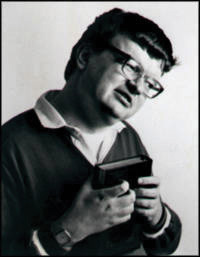
Figure \(\PageIndex{1}\): Kim Peek, the subject of the movie Rain Man, was believed to have memorized the contents of more than 10,000 books. He could read a book in about an hour. Source: Photo courtesy of Darold A. Treffert, MD, and the Wisconsin Medical Society, http://commons.wikimedia.org/wiki/File:Peek1.jpg.
Video Clip: Kim Peek
(click to see video) You can view an interview with Kim Peek and see some of his amazing memory abilities at this link.
In this chapter we will see how psychologists use behavioral responses (such as memory tests and reaction times) to draw inferences about what and how people remember. And we will see that although we have very good memory for some things, our memories are far from perfect (Schacter, 1996). The errors that we make are due to the fact that our memories are not simply recording devices that input, store, and retrieve the world around us. Rather, we actively process and interpret information as we remember and recollect it, and these cognitive processes influence what we remember and how we remember it. Because memories are constructed, not recorded, when we remember events we don’t reproduce exact replicas of those events (Bartlett, 1932). People who read the words “dream, sheets, rest, snore, blanket, tired, and bed” and then are asked to remember the words often think that they saw the word sleep even though that word was not in the list (Roediger & McDermott, 1995). Our cognitive processes influence the accuracy and inaccuracy of our memories and our judgments, and they lead us to be vulnerable to the types of errors that eyewitnesses may make.
In other sections of this chapter we examine the biology of memory including brain areas involved in memory and changes in the brain when a memory is formed. But first we explore the types, processes, and stages of memory.
Memories as Types and Stages
As you can see in Table 10.10.1 "Memory Conceptualized in Terms of Types, Stages, and Processes", psychologists conceptualize memory in terms of types, in terms of stages, and in terms of processes. In this section we will consider the two types of memory, explicit memory and implicit memory, and then the three major memory stages: sensory, short-term, and long-term (Atkinson & Shiffrin, 1968). Then, in the next section, we will consider the nature of long-term memory, with a particular emphasis on the three processes that are central to long-term memory: encoding, storage, and retrieval.
| As types | Explicit memory |
| Implicit memory | |
| As stages | Sensory memory |
| Short-term memory | |
| Long-term memory | |
| As processes | Encoding |
| Storage | |
| Retrieval |
Table 10.10.1 Memory Conceptualized in Terms of Types, Stages, and Processes
Explicit Memory
When we assess memory by asking a person to consciously remember things, we are measuring explicit memory. Explicit memory refers to knowledge or experiences that can be consciously remembered. As you can see in Figure 10.4.2, "Types of Memory," there are two types of explicit memory: episodic and semantic. Episodic memory refers to memories of the firsthand experiences that we have had (i.e. memories of episodes in one's life; for example, recollections of our high school graduation day or of the fantastic dinner you had in New York last year). Semantic memory refers to our knowledge of facts and concepts about the world (e.g., that the absolute value of −90 is greater than the absolute value of 9 and that one definition of the word “affect” is “the experience of feeling or emotion”).

Figure \(\PageIndex{2}\): Types of Memory. Explicit memory is divided into semantic and episodic. Implicit memory includes procedural memory for motor and cognitive skills, priming, and classical conditioning.
Explicit memory is assessed using measures in which the individual being tested must consciously attempt to remember the information. A recall memory test is a measure of explicit memory that involves bringing from memory information that has previously been remembered. We rely on our recall memory when we take an essay test, because the test requires us to generate previously remembered information. A multiple-choice test is an example of a recognition memory test, a measure of explicit memory that involves determining whether information has been seen or learned before.
Your own experiences taking tests will probably lead you to agree with the scientific research finding that recall is more difficult than recognition. Recall, such as required on essay tests, involves two steps: first generating an answer and then determining whether it seems to be the correct one. Recognition, as on multiple-choice test, only involves determining which item from a list seems most correct (Haist, Shimamura, & Squire, 1992). Although they involve different processes, recall and recognition memory measures tend to be correlated. Students who do better on a multiple-choice exam will also, by and large, do better on an essay exam (Bridgeman & Morgan, 1996).
A third way of measuring memory is known as relearning (Nelson, 1985). Measures of relearning (or savings) assess how much more quickly information is processed or learned when it is studied again after it has already been learned but then forgotten. If you have taken some French courses in the past, for instance, you might have forgotten most of the vocabulary you learned. But if you were to work on your French again, you’d learn the vocabulary much faster the second time around. Relearning can be a more sensitive measure of memory than either recall or recognition because it allows assessing memory in terms of “how much” or “how fast” rather than simply “correct” versus “incorrect” responses. Relearning also allows us to measure memory for procedures like driving a car or playing a piano piece, as well as memory for facts and figures.
Implicit Memory
While explicit memory consists of the things that we can consciously report that we know, implicit memory refers to knowledge that we cannot consciously access. However, implicit memory is nevertheless exceedingly important to us because it has a direct effect on our behavior. Implicit memory refers to the influence of experience on behavior, even if the individual is not aware of those influences. As you can see in Figure 10.4.2, "Types of Memory," there are three general types of implicit memory: procedural (motor) memory, classical conditioning effects, and priming.
Procedural memory refers to our often unexplainable knowledge of how to do things. When we walk from one place to another, speak to another person in English, dial a cell phone, or play a video game, we are using procedural memory. Procedural memory allows us to perform complex tasks, even though we may not be able to explain to others how we do them. There is no way to tell someone how to ride a bicycle; a person has to learn by doing it. The idea of implicit memory helps explain how infants are able to learn. The ability to crawl, walk, and talk are procedures, and these motor skills are easily and efficiently developed while we are children despite the fact that as adults we have no conscious memory of having learned them.
A second type of implicit memory is classical conditioning effects, in which we learn, often without effort or awareness, to associate neutral stimuli (such as a sound or a light) with another stimulus (such as food), which creates a naturally occurring response, such as enjoyment or salivation. The memory for the association is demonstrated when the conditioned stimulus (the sound of the bell) begins to create the same response as the unconditioned stimulus (the food) did before the learning of the predictive relation between bell and food, the CS and US.
The final type of implicit memory is known as priming, or changes in behavior as a result of experiences that have happened frequently or recently. Priming refers both to the activation of knowledge (e.g., we can prime the concept of “kindness” by presenting people with words related to kindness) and to the influence of that activation on behavior (people who are primed with the concept of kindness may act more kindly).
One measure of the influence of priming on implicit memory is the word fragment test, in which a person is asked to fill in missing letters to make words. You can try this yourself: First, try to complete the following word fragments, but work on each one for only three or four seconds. Do any words pop into mind quickly?
_ i b _ a _ y
_ h _ s _ _ i _ n
_ o _ k
_ h _ i s _
Now read the following sentence carefully:
“He got his materials from the shelves, checked them out, and then left the building.”
Then try again to make words out of the word fragments.
I think you might find that it is easier to complete fragments 1 and 3 as “library” and “book,” respectively, after you read the sentence than it was before you read it. However, reading the sentence didn’t really help you to complete fragments 2 and 4 as “physician” and “chaise.” This difference in implicit memory probably occurred because as you read the sentence, the concept of “library” (and perhaps “book”) was primed, even though they were never mentioned explicitly. Once a concept is primed it influences our behaviors, for instance, on word fragment tests.
Our everyday behaviors are influenced by priming in a wide variety of situations. Seeing an advertisement for cigarettes may make us start smoking, seeing the flag of our home country may arouse our patriotism, and seeing a student from a rival school may arouse our competitive spirit. And these influences on our behaviors may occur without our being aware of them.
Stages of Memory: Sensory, Short-Term, and Long-Term Memory
Another way of understanding memory is to think about it in terms of stages that describe the length of time that information remains available to us. According to this approach (see Figure 10.4.3), information begins in sensory memory, moves to short-term memory, and eventually moves to long-term memory. But not all information makes it through all three stages; most of it is forgotten. Whether the information moves from shorter-duration memory into longer-duration memory or whether it is lost from memory entirely depends on how the information is attended to and processed.
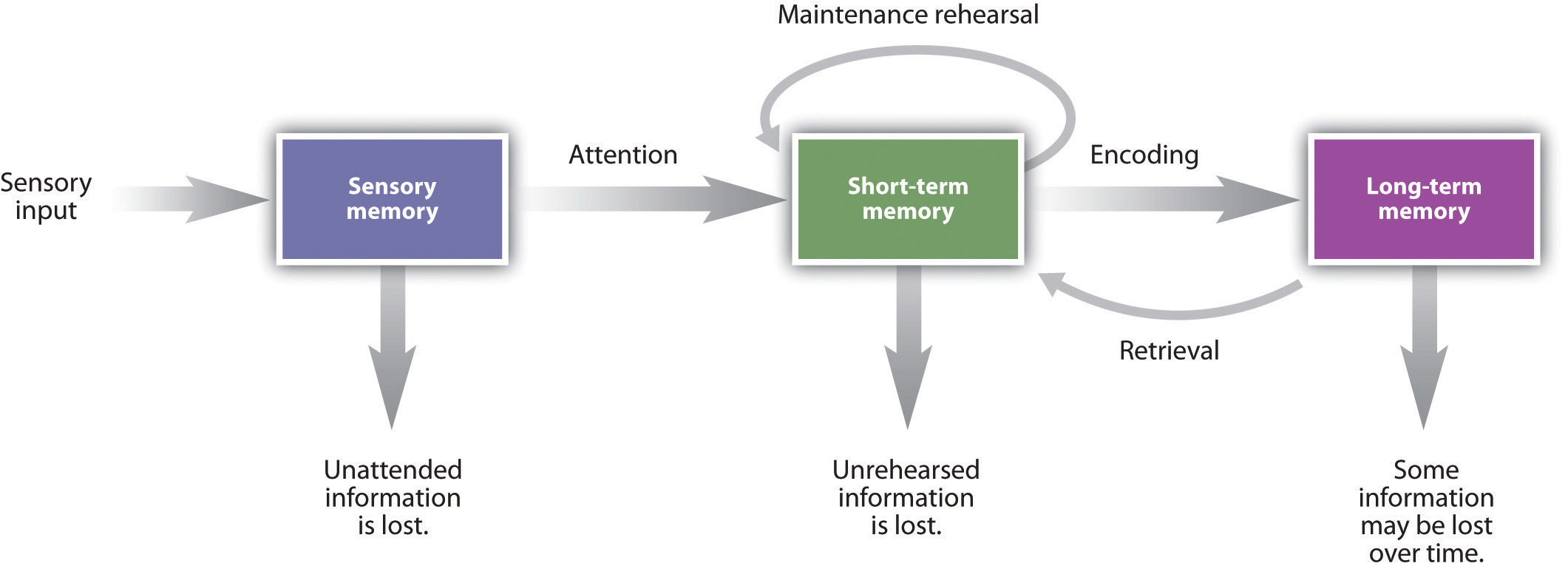
Figure \(\PageIndex{3}\): Memory Duration. Memory can characterized in terms of stages—the length of time that information remains available to us.
Source: Adapted from Atkinson, R. C., & Shiffrin, R. M. (1968). Human memory: A proposed system and its control processes. In K. Spence (Ed.), The psychology of learning and motivation (Vol. 2). Oxford, England: Academic Press.
Sensory Memory
Sensory memory refers to the brief storage of sensory information. Sensory memory is a memory buffer that lasts only very briefly and then, unless it is attended to and passed on for more processing, is forgotten. The purpose of sensory memory is to give the brain some time to process the incoming sensations, and to allow us to see the world as an unbroken stream of events rather than as individual pieces.
Visual sensory memory is known as iconic memory. Iconic memory was first studied by the psychologist George Sperling (1960). In his research, Sperling showed participants a display of letters in rows, similar to that shown in Figure 10.4.3, below. However, the display lasted only about 50 milliseconds (1/20 of a second). Then, Sperling gave his participants a recall test in which they were asked to name all the letters that they could remember. On average, the participants could remember only about one-quarter of the letters that they had seen.
Figure \(\PageIndex{4}\): Measuring Iconic Memory.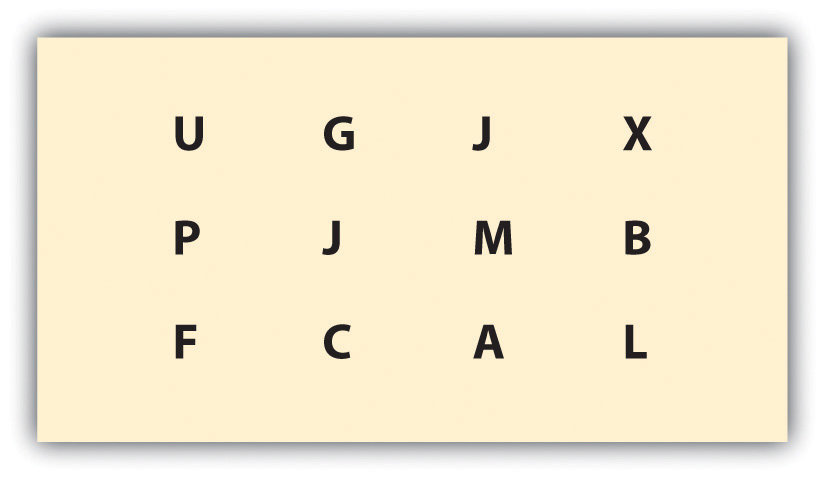
Adapted from Sperling, G. (1960). The information available in brief visual presentation. Psychological Monographs, 74(11), 1–29.
Sperling (1960) showed his participants displays such as this one for only 1/20th of a second. He found that when he cued the participants to report one of the three rows of letters, they could do it, even if the cue was given shortly after the display had been removed. The research demonstrated the existence of iconic memory.
Sperling reasoned that the participants had seen all the letters but could remember them only very briefly, making it impossible for them to report them all. To test this idea, in his next experiment he first showed the same letters, but then after the display had been removed, he signaled to the participants to report the letters from either the first, second, or third row. In this condition, the participants now reported almost all the letters in that row. This finding confirmed Sperling’s hunch: Participants had access to all of the letters in their iconic memories, and if the task was short enough, they were able to report on the part of the display he asked them to. The “short enough” is the length of iconic memory, which turns out to be about 250 milliseconds (¼ of a second).
Auditory sensory memory is known as echoic memory. In contrast to iconic memories, which decay very rapidly, echoic memories can last as long as 4 seconds (Cowan, Lichty, & Grove, 1990). This is convenient as it allows you—among other things—to remember the words that you said at the beginning of a long sentence when you get to the end of it, and to take notes on your psychology professor’s most recent statement even after he or she has finished saying it.
In some people iconic memory seems to last longer, a phenomenon known as eidetic imagery (or “photographic memory”) in which people can report details of an image over long periods of time. These people, who often suffer from psychological disorders such as autism, claim that they can “see” an image long after it has been presented, and can often report accurately on that image. There is also some evidence for eidetic memories in hearing; some people report that their echoic memories persist for unusually long periods of time. The composer Wolfgang Amadeus Mozart may have possessed eidetic memory for music, because even when he was very young and had not yet had a great deal of musical training, he could listen to long compositions and then play them back almost perfectly (Solomon, 1995).
Short-Term Memory
Most of the information that gets into sensory memory is forgotten, but information that we turn our attention to, with the goal of remembering it, may pass into short-term memory. Short-term memory (STM) is the place where small amounts of information can be temporarily kept for more than a few seconds but usually for less than one minute (Baddeley, Vallar, & Shallice, 1990). Information in short-term memory is not stored permanently. Although often conceptualized as an intermediate stage between snesory memory and long-term memory, it is also used when we are working on a task, such as doing a long division problem, where the task requires that we keep some itmes of information in mind. For this reason, it is often called working memory.
Although it is called “memory,” working memory is not a store of memory like STM but rather a set of memory procedures or operations. Imagine, for instance, that you are asked to participate in a task such as this one, which is a measure of working memory (Unsworth & Engle, 2007). Each of the following questions appears individually on a computer screen and then disappears after you answer the question:
| Is 10 × 2 − 5 = 15? (Answer YES OR NO) Then remember “S” | |
| Is 12 ÷ 6 − 2 = 1? (Answer YES OR NO) Then remember “R” | |
| Is 10 × 2 = 5? (Answer YES OR NO) Then remember “P” | |
| Is 8 ÷ 2 − 1 = 1? (Answer YES OR NO) Then remember “T” | |
| Is 6 × 2 − 1 = 8? (Answer YES OR NO) Then remember “U” | |
| Is 2 × 3 − 3 = 0? (Answer YES OR NO) Then remember “Q” |
To successfully accomplish the task, you have to answer each of the math problems correctly and at the same time remember the letter that follows the task. Then, after the six questions, you must list the letters that appeared in each of the trials in the correct order (in this case S, R, P, T, U, Q).
To accomplish this difficult task you need to use a variety of skills. You clearly need to use STM, as you must keep the letters in storage until you are asked to list them. But you also need a way to make the best use of your available attention and processing. For instance, you might decide to use a strategy of “repeat the letters twice, then quickly solve the next problem, and then repeat the letters twice again including the new one.” Keeping this strategy (or others like it) going is the role of working memory’s central executive—the part of working memory that directs attention and processing. The central executive will make use of whatever strategies seem to be best for the given task. For instance, the central executive will direct the rehearsal process, and at the same time direct the visual cortex to form an image of the list of letters in memory. You can see that although STM is involved, the processes that we use to operate on the material in memory are also critical.
Short-term memory is limited in both the length and the amount of information it can hold. Peterson and Peterson (1959) found that when people were asked to remember a list of three-letter strings and then were immediately asked to perform a distracting task (counting backward by threes), the material was quickly forgotten (see Figure 10.4.4), such that by 18 seconds it was virtually gone.
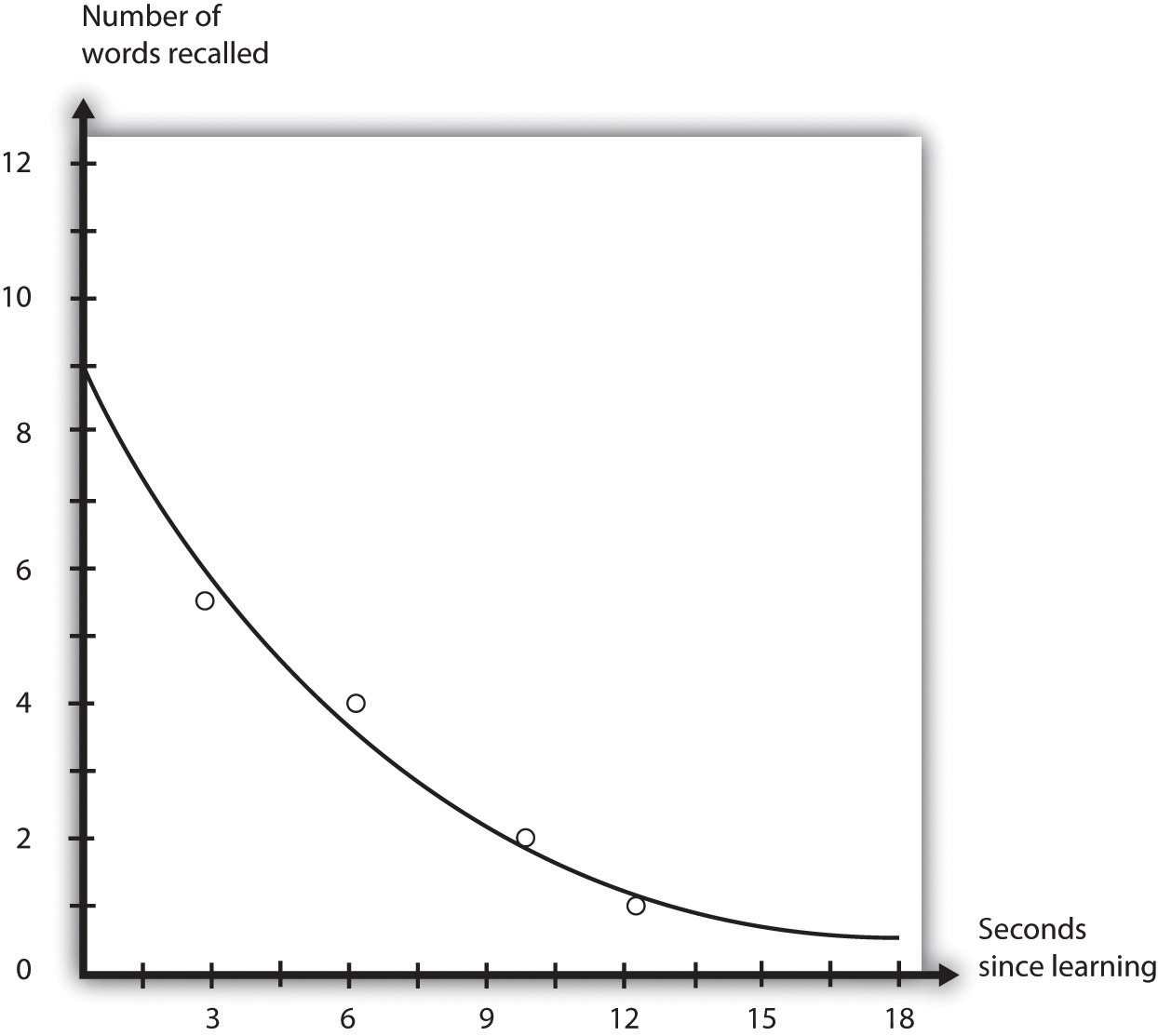
Figure \(\PageIndex{5}\): . STM Decay. Peterson and Peterson (1959) found that information that was not rehearsed decayed quickly from memory. Source: Adapted from Peterson, L., & Peterson, M. J. (1959). Short-term retention of individual verbal items. Journal of Experimental Psychology, 58(3), 193–198.
One way to prevent the decay of information from short-term memory is to use working memory to rehearse it. Maintenance rehearsal is the process of repeating information mentally or out loud with the goal of keeping it in memory. We engage in maintenance rehearsal to keep a something that we want to remember (e.g., a person’s name, e-mail address, or phone number) in mind long enough to write it down, use it, or potentially transfer it to long-term memory.
If we continue to rehearse information it will stay in STM until we stop rehearsing it, but there is also a capacity limit to STM. Try reading each of the following rows of numbers, one row at a time, at a rate of about one number each second. Then when you have finished each row, close your eyes and write down as many of the numbers as you can remember.
019
3586
10295
861059
1029384
75674834
657874104
6550423897
If you are like the average person, you will have found that on this test of working memory, known as a digit span test, you did pretty well up to about the fourth line, and then you started having trouble. I bet you missed some of the numbers in the last three rows, and did pretty poorly on the last one.
The digit span of most adults is between five and nine digits, with an average of about seven. The cognitive psychologist George Miller (1956) referred to “seven plus or minus two” pieces of information as the “magic number” in short-term memory. But if we can only hold a maximum of about nine digits in short-term memory, then how can we remember larger amounts of information than this? For instance, how can we ever remember a 10-digit phone number long enough to dial it?
One way we are able to expand our ability to remember things in STM is by using a memory technique called chunking. Chunking is the process of organizing information into smaller groupings (chunks), thereby increasing the number of items that can be held in STM. For instance, try to remember this string of 12 letters:
XOFCBANNCVTM
You probably won’t do that well because the number of letters is more than the magic number of seven.
Now try again with this one:
MTVCNNABCFOX
Would it help you if I pointed out that the material in this string could be chunked into four sets of three letters each? I think it would, because then rather than remembering 12 letters, you would only have to remember the names of four television stations. In this case, chunking changes the number of items you have to remember from 12 to only four. This works because you are already very familiar with the letter triplets that are used to refer to these well known TV networks. That knowledge which is already fixed in your memory can be brought to the task at hand to make the memory task easier.
Experts rely on chunking to help them process complex information. Herbert Simon and William Chase (1973) showed chess masters and chess novices various positions of pieces on a chessboard for a few seconds each. The experts did a lot better than the novices in remembering the positions because they were able to see the “big picture.” They didn’t have to remember the position of each of the pieces individually, but chunked the pieces into several larger layouts. But when the researchers showed both groups random chess positions—positions that would be very unlikely to occur in real games—both groups did equally poorly, because in this situation the experts lost their ability to organize the layouts (see Figure 10.4.6. "Possible and Impossible Chess Positions," below). The same occurs for basketball. Basketball players recall actual basketball positions much better than do nonplayers, but only when the positions make sense in terms of what is happening on the court, or what is likely to happen in the near future, and thus can be chunked into bigger units (Didierjean & Marmèche, 2005).
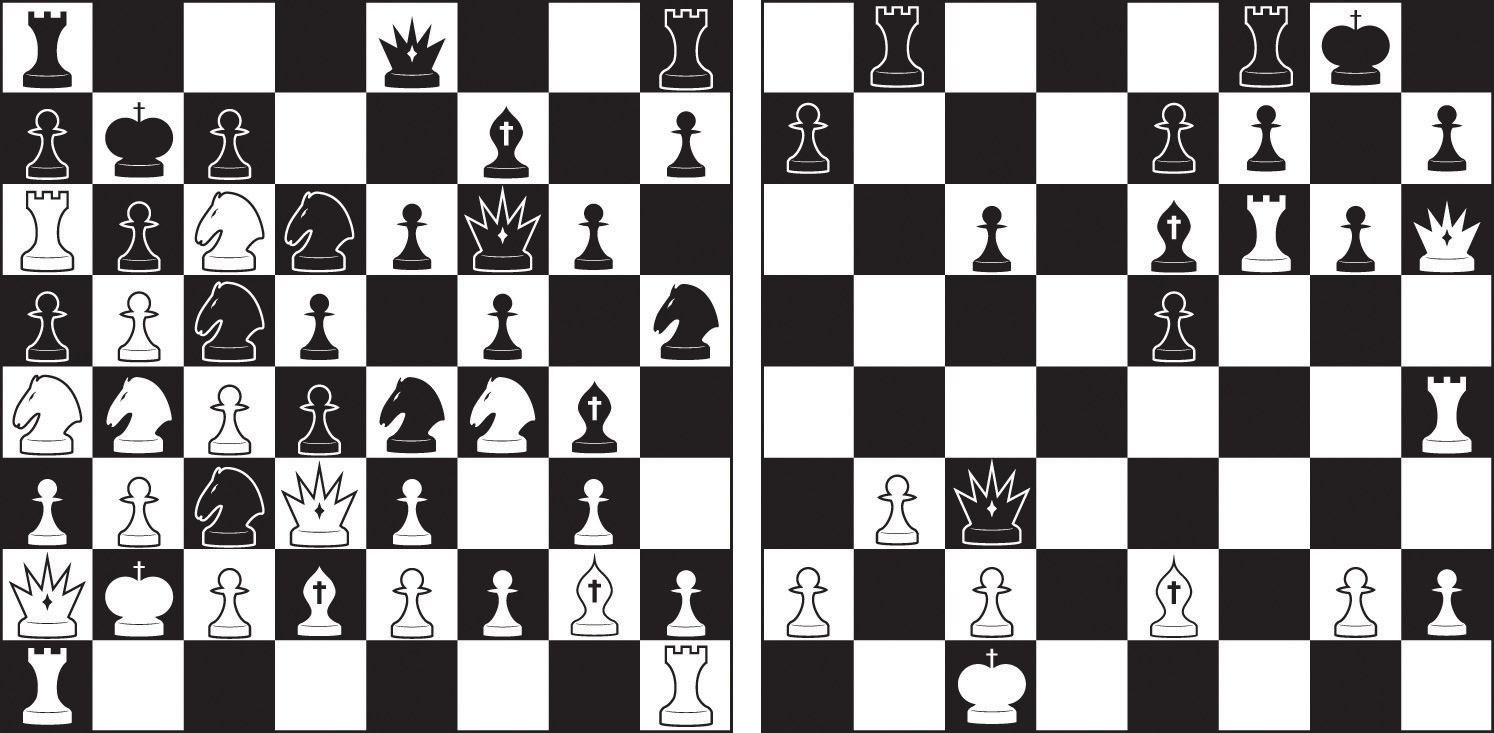
Figure \(\PageIndex{6}\): Possible and Impossible Chess Positions. Experience matters: Experienced chess players are able to recall the positions of the game on the right much better than are those who are chess novices. But the experts do no better than the novices in remembering the positions on the left, which cannot occur in a real game.
Long-Term Memory
If information makes it past short term-memory it may enter long-term memory (LTM), memory storage that can hold information for days, months, and years. The capacity of long-term memory is large, and there is no known limit to what we can remember (Wang, Liu, & Wang, 2003). Although we may forget at least some information after we learn it, other things will stay with us forever. In the next section we will discuss the principles of long-term memory.
KEY TAKEAWAYS
- Memory refers to the ability to store and retrieve information over time.
- For some things our memory is very good, but our active cognitive processing of information assures that memory is never an exact replica of what we have experienced.
- Explicit memory refers to experiences that can be intentionally and consciously remembered, and it is measured using recall, recognition, and relearning. Explicit memory includes episodic and semantic memories.
- Measures of relearning (also known as savings) assess how much more quickly information is learned when it is studied again after it has already been learned but then forgotten.
- Implicit memory refers to the influence of experience on behavior, even if the individual is not aware of those influences. The three types of implicit memory are procedural memory, classical conditioning, and priming.
- Information processing begins in sensory memory, moves to short-term memory, and eventually moves to long-term memory.
- Maintenance rehearsal and chunking are used to keep information in short-term memory.
- The capacity of long-term memory is large, and there is no known limit to what we can remember.
EXERCISES AND CRITICAL THINKING
- List some situations in which sensory memory is useful for you. What do you think your experience of the stimuli would be like if you had no sensory memory?
- Describe a situation in which you need to use working memory to perform a task or solve a problem. How do your working memory skills help you?
References
Atkinson, R. C., & Shiffrin, R. M. (1968). Human memory: A proposed system and its control processes. In K. Spence (Ed.), The psychology of learning and motivation (Vol. 2). Oxford, England: Academic Press.
Bahrick, H. P. (2000). Long-term maintenance of knowledge. In E. Tulving & F. I. M. Craik (Eds.), The Oxford handbook of memory (pp. 347–362). New York, NY: Oxford University Press.
Bartlett, F. C. (1932). Remembering. Cambridge, MA: Cambridge University Press.
Luria, A. (2004). The mind of a mnemonist: A little book about a vast memory. Cambridge, MA: Harvard University Press.
Mitchell, D. B. (2006). Nonconscious priming after 17 years: Invulnerable implicit memory? Psychological Science, 17 (11), 925–928.
Roediger, H. L., & McDermott, K. B. (1995). Creating false memories: Remembering words not presented in lists. Journal of Experimental Psychology: Learning, Memory, and Cognition, 21(4), 803–814.
Schacter, D. L. (1996). Searching for memory: The brain, the mind, and the past (1st ed.). New York, NY: Basic Books.
Wisconsin Medical Society. (n.d.). Retrieved from http://www.wisconsinmedicalsociety.org/_SAVANT/_PROFILES/kim_peek/_media/video/expedition/video.html
Additional References
Baddeley, A. D., Vallar, G., & Shallice, T. (1990). The development of the concept of working memory: Implications and contributions of neuropsychology. In G. Vallar & T. Shallice (Eds.), Neuropsychological impairments of short-term memory (pp. 54–73). New York, NY: Cambridge University Press.
Bridgeman, B., & Morgan, R. (1996). Success in college for students with discrepancies between performance on multiple-choice and essay tests. Journal of Educational Psychology, 88 (2), 333–340.
Cowan, N., Lichty, W., & Grove, T. R. (1990). Properties of memory for unattended spoken syllables. Journal of Experimental Psychology: Learning, Memory, and Cognition, 16(2), 258–268.
Didierjean, A., & Marmèche, E. (2005). Anticipatory representation of visual basketball scenes by novice and expert players. Visual Cognition, 12(2), 265–283.
Haist, F., Shimamura, A. P., & Squire, L. R. (1992). On the relationship between recall and recognition memory. Journal of Experimental Psychology: Learning, Memory, and Cognition, 18 (4), 691–702.
Miller, G. A. (1956). The magical number seven, plus or minus two: Some limits on our capacity for processing information. Psychological Review, 63(2), 81–97.
Nelson, T. O. (1985). Ebbinghaus’s contribution to the measurement of retention: Savings during relearning. Journal of Experimental Psychology: Learning, Memory, and Cognition, 11 (3), 472–478.
Peterson, L., & Peterson, M. J. (1959). Short-term retention of individual verbal items. Journal of Experimental Psychology, 58(3), 193–198.
Simon, H. A., & Chase, W. G. (1973). Skill in chess. American Scientist, 61 (4), 394–403.
Solomon, M. (1995). Mozart: A life. New York, NY: Harper Perennial.
Sperling, G. (1960). The information available in brief visual presentation. Psychological Monographs, 74 (11), 1–29. I
Unsworth, N., & Engle, R. W. (2007). On the division of short-term and working memory: An examination of simple and complex span and their relation to higher order abilities. Psychological Bulletin, 133 (6), 1038–1066.
Wang, Y., Liu, D., & Wang, Y. (2003). Discovering the capacity of human memory. Brain & Mind, 4(2), 189–198.
The Structure of LTM: Categories, Prototypes, and Schemas
Memories that are stored in LTM are not isolated but rather are linked together into categories—networks of associated memories that have features in common with each other. Forming categories, and using categories to guide behavior, is a fundamental part of human nature. Associated concepts within a category are connected through spreading activation, which occurs when activating one element of a category activates other associated elements. For instance, because tools are associated in a category, reminding people of the word “screwdriver” will help them remember the word “wrench.” And, when people have learned lists of words that come from different categories, they do not recall the information haphazardly. If they have just remembered the word “wrench,” they are more likely to remember the word “screwdriver” next than they are to remember the word “dahlia,” because the words are organized in memory by category and because “dahlia” is activated by spreading activation from “wrench” (Srull & Wyer, 1989).
Some categories have defining features that must be true of all members of the category. For instance, all members of the category “triangles” have three sides, and all members of the category “birds” lay eggs. But most categories are not so well-defined; the members of the category share some common features, but it is impossible to define which are or are not members of the category. For instance, there is no clear definition of the category “tool.” Some examples of the category, such as a hammer and a wrench, are clearly and easily identified as category members, whereas other members are not so obvious. Is an ironing board a tool? What about a car?
Members of categories (even those with defining features) can be compared to the category prototype, which is the member of the category that is most average or typical of the category. Some category members are more prototypical of, or similar to, the category than others. For instance, some category members (robins and sparrows) are highly prototypical of the category “birds,” whereas other category members (penguins and ostriches) are less prototypical. We retrieve information that is prototypical of a category faster than we retrieve information that is less prototypical (Rosch, 1975).
Mental categories are sometimes referred to as schemas—patterns of knowledge in long-term memory that help us organize information. We have schemas about objects (that a triangle has three sides and may take on different angles), about people (that Sam is friendly, likes to golf, and always wears sandals), about events (the particular steps involved in ordering a meal at a restaurant), and about social groups (we call these group schemas stereotypes).
Schemas are important in part because they help us remember new information by providing an organizational structure for it. Read the following paragraph (Bransford & Johnson, 1972) and then try to write down everything you can remember.
The procedure is actually quite simple. First you arrange things into different groups. Of course, one pile may be sufficient depending on how much there is to do. If you have to go somewhere else due to lack of facilities, that is the next step; otherwise you are pretty well set. It is important not to overdo things. That is, it is better to do too few things at once than too many. In the short run this may not seem important, but complications can easily arise. A mistake can be expensive as well. At first the whole procedure will seem complicated. Soon, however, it will become just another facet of life. It is difficult to foresee any end to the necessity for this task in the immediate future, but then one never can tell. After the procedure is completed, one arranges the materials into different groups again. Then they can be put into their appropriate places. Eventually they will be used once more and the whole cycle will then have to be repeated. However, that is part of life.
It turns out that people’s memory for this information is quite poor, unless they have been told ahead of time that the information describes “doing the laundry,” in which case their memory for the material is much better. This demonstration of the role of schemas in memory shows how our existing knowledge can help us organize new information, and how this organization can improve encoding, storage, and retrieval.
References
Bransford, J. D. & Johnson, M. K. (1972). Contextual prerequisites for understanding: Some investigations of comprehension and recall. Journal of Verbal Learning & Verbal Behavior, 11 (6), 717–726.
Rosch, E. (1975). Cognitive representations of semantic categories. Journal of Experimental Psychology: General, 104 (3), 192–233.
Srull, T. & Wyer, R. (1989). Person memory and judgment. Psychological Review, 96 (1), 58–83.
Counterfactual Thinking
In addition to influencing our judgments about ourselves and others, the ease with which we can retrieve potential experiences from memory can have an important effect on our own emotions. If we can easily imagine an outcome that is better than what actually happened, then we may experience sadness and disappointment; on the other hand, if we can easily imagine that a result might have been worse than what actually happened, we may be more likely to experience happiness and satisfaction. The tendency to think about and experience events according to “what might have been” is known as counterfactual thinking (Kahneman & Miller, 1986; Roese, 2005).
Imagine, for instance, that you were participating in an important contest, and you won the silver (second-place) medal. How would you feel? Certainly you would be happy that you won the silver medal, but wouldn’t you also be thinking about what might have happened if you had been just a little bit better—you might have won the gold medal! On the other hand, how might you feel if you won the bronze (third-place) medal? If you were thinking about the counterfactuals (the “what might have beens”) perhaps the idea of not getting any medal at all would have been highly accessible; you’d be happy that you got the medal that you did get, rather than coming in fourth.
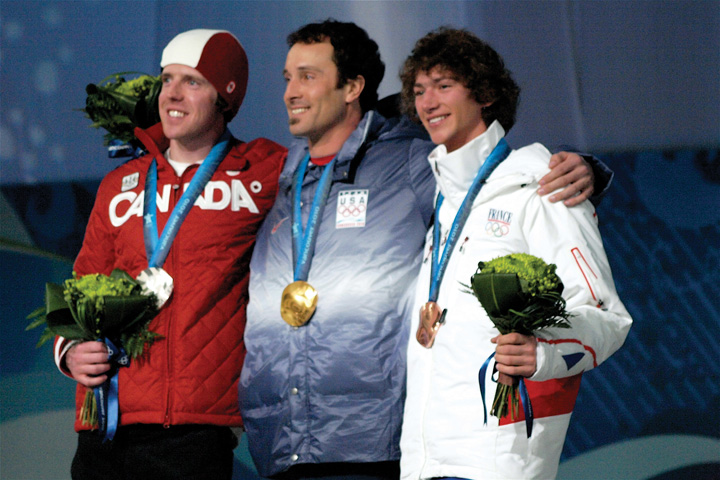
Figure \(\PageIndex{7}\): Counterfactual Thinking. Does the bronze medalist look happier to you than the silver medalist? Medvec, V. H., Madey, S. F., & Gilovich, T. (1995). When less is more: Counterfactual thinking and satisfaction among Olympic medalists. Journal of Personality & Social Psychology, 69(4), 603–610. found that, on average, bronze medalists were happier. Source: Photo courtesy of kinnigurl, http://commons.wikimedia.org/wiki/ File:2010_Winter_Olympic_Men%27s_Snowboard_ Cross_medalists.jpg.
Tom Gilovich and his colleagues (Medvec, Madey, & Gilovich, 1995) investigated this idea by videotaping the responses of athletes who won medals in the 1992 Summer Olympic Games. They videotaped the athletes both as they learned that they had won a silver or a bronze medal and again as they were awarded the medal. Then the researchers showed these videos, without any sound, to raters who did not know which medal which athlete had won. The raters were asked to indicate how they thought the athlete was feeling, using a range of feelings from “agony” to “ecstasy.” The results showed that the bronze medalists were, on average, rated as happier than were the silver medalists. In a follow-up study, raters watched interviews with many of these same athletes as they talked about their performance. The raters indicated what we would expect on the basis of counterfactual thinking—the silver medalists talked about their disappointments in having finished second rather than first, whereas the bronze medalists focused on how happy they were to have finished third rather than fourth.
You might have experienced counterfactual thinking in other situations. Once I was driving across country, and my car was having some engine trouble. I really wanted to make it home when I got near the end of my journey; I would have been extremely disappointed if the car broke down only a few miles from my home. Perhaps you have noticed that once you get close to finishing something, you feel like you really need to get it done. Counterfactual thinking has even been observed in juries. Jurors who were asked to award monetary damages to others who had been in an accident offered them substantially more in compensation if they barely avoided injury than they offered if the accident seemed inevitable (Miller, Turnbull, & McFarland, 1988).
References
Kahneman, D., & Miller, D. T. (1986). Norm theory: Comparing reality to its alternatives. Psychological Review, 93, 136–153; Roese, N. (2005). If only: How to turn regret into opportunity. New York, NY: Broadway Books.
Medvec, V. H., Madey, S. F., & Gilovich, T. (1995). When less is more: Counterfactual thinking and satisfaction among Olympic medalists. Journal of Personality & Social Psychology, 69 (4), 603–610.
Miller, D. T., Turnbull, W., & McFarland, C. (1988). Particularistic and universalistic evaluation in the social comparison process. Journal of Personality and Social Psychology, 55, 908–917.
Attributions
Licensing Information
This module, 10.4, was adapted by Saylor Academy under a Creative Commons Attribution-NonCommercial-ShareAlike 3.0 License without attribution as requested by the work's original creator or licensor.
Saylor Academy would like to thank Andy Schmitz for his work in maintaining and improving the HTML versions of these textbooks. This textbook is adapted from his HTML version, and his project can be found here.
How to cite this work:
- Publisher: Saylor Academy
- Year Published: 2012



